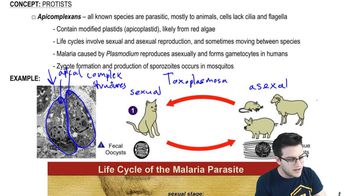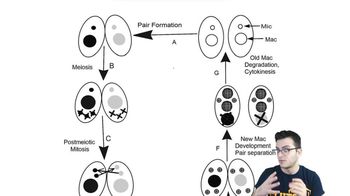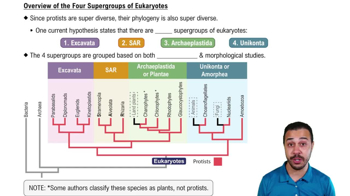>The Plasmodium Life Cycle >Parasitism is a form of consumption in which one organism (the parasite) consumes relatively small amounts of tissue or nutrients from another organism, called the host. >The Plasmodium life cycle involves the interaction of three species in a complex cycle that results in malaria in humans. >There are two parasites in this scene. >The mosquito acts as a parasite by taking blood from her human host. >To ensure an even flow of blood, she first injects the site with saliva that contains an anticoagulant. >The second parasite, called Plasmodium, flows in with the saliva. >Plasmodium parasitizes the mosquito and the human, using each as a host for part of its life cycle. >Plasmodium quickly travels through the circulatory system and reaches the liver, where it specifically targets liver cells. >At this stage, the Plasmodium cells are called sporozoites. >A sporozoite invades a liver cell, where it divides many times to produce offspring that are known as merozoites. >From the liver, these offspring enter the general circulation of the body. >In the bloodstream, the merozoites continue the life cycle by infecting red blood cells. >The invading merozoite lives off the hemoglobin and other nutrients in a red blood cell, allowing the parasite to divide and produce more merozoites. >The merozoites destroy red blood cells and then find other red blood cells to infect. >The destruction of red blood cells causes anemia in the host, a potentially dangerous consequence of being infected with the malaria parasite. >Some of the merozoites in the bloodstream differentiate into male or female gametocytes. >These cells no longer use the human as a host—now they require a mosquito to continue their life cycle. >When a mosquito bites an infected human, male and female gametocytes enter the mosquito as part of the blood meal. >Once ingested, they enter the mosquito’s gut. >In the mosquito’s gut, the haploid male gametocyte develops further, producing spindlelike male cells. >These male cells fertilize haploid female cells, and diploid zygotes result. >This diploid stage of the life cycle of Plasmodium migrates into the mosquito’s gut to continue its life cycle. >These cells divide by meiosis and then by mitosis to produce many haploid sporozoites. >Sporozoites migrate to the salivary glands, where they are ready to be injected into another host the next time the mosquito bites a host. >Now you have seen the entire Plasmodium life cycle, and observed its development through two distinct hosts. >In terms of evolution, what might you expect to happen over time in a human population exposed to the Plasmodium parasite? >Combating Plasmodium >Humans are not defenseless against the Plasmodium parasite. >We have evolved some immune responses that help combat infection. >One example is shown here. >Most cells of the body, including liver cells, display proteins called HLA on their cell surfaces. >The specific types of HLA proteins depend on a person’s genotype. >Some people carry an allele called B53, which is particularly useful in combating Plasmodium. >If a Plasmodium sporozoite infects a liver cell, the liver cell can use its HLA protein as a flag to call the immune system for help. >During the infection, the liver cell puts small pieces of the parasite onto its surface. >The HLA-B53 protein is unique in its ability to bind to a Plasmodium protein called CP26. >Cells of the immune system, called cytotoxic T cells, can recognize the CP26 protein when it is displayed on the liver cell’s surface. >Cytotoxic T cells destroy the liver cell before the merozoites are released. >By alerting T cells to the infection, the B53 allele of HLA is an effective adaptation against malaria. >This adaptation is just one move in this coevolutionary arms race between the host and the parasite.
Table of contents
- 1. Introduction to Biology2h 40m
- 2. Chemistry3h 40m
- 3. Water1h 26m
- 4. Biomolecules2h 23m
- 5. Cell Components2h 26m
- 6. The Membrane2h 31m
- 7. Energy and Metabolism2h 0m
- 8. Respiration2h 40m
- 9. Photosynthesis2h 49m
- 10. Cell Signaling59m
- 11. Cell Division2h 47m
- 12. Meiosis2h 0m
- 13. Mendelian Genetics4h 41m
- Introduction to Mendel's Experiments7m
- Genotype vs. Phenotype17m
- Punnett Squares13m
- Mendel's Experiments26m
- Mendel's Laws18m
- Monohybrid Crosses16m
- Test Crosses14m
- Dihybrid Crosses20m
- Punnett Square Probability26m
- Incomplete Dominance vs. Codominance20m
- Epistasis7m
- Non-Mendelian Genetics12m
- Pedigrees6m
- Autosomal Inheritance21m
- Sex-Linked Inheritance43m
- X-Inactivation9m
- 14. DNA Synthesis2h 27m
- 15. Gene Expression3h 20m
- 16. Regulation of Expression3h 31m
- Introduction to Regulation of Gene Expression13m
- Prokaryotic Gene Regulation via Operons27m
- The Lac Operon21m
- Glucose's Impact on Lac Operon25m
- The Trp Operon20m
- Review of the Lac Operon & Trp Operon11m
- Introduction to Eukaryotic Gene Regulation9m
- Eukaryotic Chromatin Modifications16m
- Eukaryotic Transcriptional Control22m
- Eukaryotic Post-Transcriptional Regulation28m
- Eukaryotic Post-Translational Regulation13m
- 17. Viruses37m
- 18. Biotechnology2h 58m
- 19. Genomics17m
- 20. Development1h 5m
- 21. Evolution3h 1m
- 22. Evolution of Populations3h 52m
- 23. Speciation1h 37m
- 24. History of Life on Earth2h 6m
- 25. Phylogeny2h 31m
- 26. Prokaryotes4h 59m
- 27. Protists1h 12m
- 28. Plants1h 22m
- 29. Fungi36m
- 30. Overview of Animals34m
- 31. Invertebrates1h 2m
- 32. Vertebrates50m
- 33. Plant Anatomy1h 3m
- 34. Vascular Plant Transport2m
- 35. Soil37m
- 36. Plant Reproduction47m
- 37. Plant Sensation and Response1h 9m
- 38. Animal Form and Function1h 19m
- 39. Digestive System10m
- 40. Circulatory System1h 57m
- 41. Immune System1h 12m
- 42. Osmoregulation and Excretion50m
- 43. Endocrine System4m
- 44. Animal Reproduction2m
- 45. Nervous System55m
- 46. Sensory Systems46m
- 47. Muscle Systems23m
- 48. Ecology3h 11m
- Introduction to Ecology20m
- Biogeography14m
- Earth's Climate Patterns50m
- Introduction to Terrestrial Biomes10m
- Terrestrial Biomes: Near Equator13m
- Terrestrial Biomes: Temperate Regions10m
- Terrestrial Biomes: Northern Regions15m
- Introduction to Aquatic Biomes27m
- Freshwater Aquatic Biomes14m
- Marine Aquatic Biomes13m
- 49. Animal Behavior28m
- 50. Population Ecology3h 41m
- Introduction to Population Ecology28m
- Population Sampling Methods23m
- Life History12m
- Population Demography17m
- Factors Limiting Population Growth14m
- Introduction to Population Growth Models22m
- Linear Population Growth6m
- Exponential Population Growth29m
- Logistic Population Growth32m
- r/K Selection10m
- The Human Population22m
- 51. Community Ecology2h 46m
- Introduction to Community Ecology2m
- Introduction to Community Interactions9m
- Community Interactions: Competition (-/-)38m
- Community Interactions: Exploitation (+/-)23m
- Community Interactions: Mutualism (+/+) & Commensalism (+/0)9m
- Community Structure35m
- Community Dynamics26m
- Geographic Impact on Communities21m
- 52. Ecosystems2h 36m
- 53. Conservation Biology24m
27. Protists
Eukaryotic Supergroups: Exploring Protist Diversity
Video duration:
4mPlay a video:
Related Videos
Related Practice





























